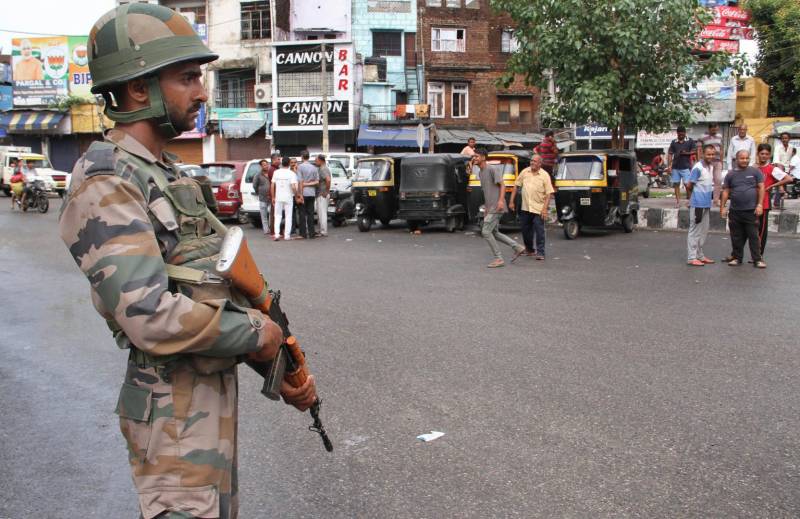J&K stares at huge losses as attacks on migrant labourers rise
By Ishfaq
Srinagar: At the crack of dawn on Wednesday, Ghulam Mohammad (name changed) of Katrosa village in Kulgam rushed to the police station along with two migrant labourers to ensure their safety. For the last few days, the two labourers from West Bengal were working in Mohammad’s orchards to harvest apples.
When militants killed five labourers on Tuesday evening, Mohammad feared for their lives. On Wednesday at dawn, Mohammad asked his son to take them to the police station so that they remain in safe hands and away from the gaze of militants. “I told my son to hand them over to police so that they remain safe”, said Mohammad.
Two labourers were part of the small group that were putting up in Katrusa village unmindful of the attacks on non-locals in neighbouring villages of south Kashmir. Five labourers were killed and another injured when militants barged into their rented accommodation at Katrosa village. One of them, who had gone to fetch food, survived the attack as he was not present at home. Police said Siraj Molvi led Hizbul Mujhadeen group was responsible for the killings.
For the last three weeks, militants have stepped up attacks on non-locals killing 11 people including truckers, labourers and apple traders. Fear has gripped apple growers as fruit export, mostly from south Kashmir has come to a grinding halt.
Kashmir’s apple economy, which contributes seven percent to the Gross State Domestic Product of Jammu and Kashmir, is fighting for survival. Militants have crumbled the economy by attacking non-local truck drivers and migrant labourers.
Figures released by Horticulture department reveal that around 65701 trucks carrying 9.09 lakh metric tonnes of apple were exported to outside state markets. “This includes 2.5 lakh apple boxes exported by NAFED. This year harvesting was late and that is why the export is less compared to the last year. The recent incidents have not had any impact”, said Ajaz Ahmad Bhat, Director Horticulture, Kashmir.
Horticulture is the mainstay of Kashmir’s economy with seven lakh families directly and indirectly associated with the sector. More than 3.38 lakh hectares of land is under the fruit cultivation in the valley. Of which 1.62 lakh hectares is under the apple cultivation. Last year the fruit production including dry fruits touched 23.30 lakh tonnes last year compared to 22.34 lakh tonnes in 2017.
Jammu and Kashmir is the largest producer of apple in the country with production touching 18.28 lakh metric tonnes last year. The apple production was 17.27 lakh metric tonnes in 2017.
Migrant labourers are the backbone of the workforce that helps in harvesting apples in Kashmir. Since local laborers are scarce, migrant labourers are skilled and inexpensive. “We provide them wages between Rs 450 to Rs 500 per day per labourer. Plus they are given two square meals and tea”, said a grower
Kashmir Chamber of Commerce and Industry (KCCI) figures reveal that around three to four migrant lakh labourers arrive in the valley annually. “You name any sector and you will find outside workers. They are highly skilled people. Most of the workforce had left after the tourism advisory in August. Now recent incidents will have impact on those who were still in the valley”, said Sheikh Ashiq Ahmad, president KCCI.
Apple industry apart, tourism sector is feeling the heat of the recent killings. After tourism advisory was withdrawn, tour operators were hoping that the government would restore internet so that they could start booking for the coming winter season.
After the recent killings of non-locals, tourism players are keeping fingers crossed about the tourist arrivals. “Tourism is already on death bed. If these things (killings) continue like this, it will definitely have an impact. As of now, nothing is normal in Kashmir. Everything is abnormal. We need to have confidence building measures. No one will take family to a place which is shut. Peace is imperative for tourism”, said Ashiq.
Kashmir on August 2 became no-zone for tourists when government issued an advisory for tourists citing threat to Amarnath yatra. Thousands of tourists curtailed their visit while those aspiring to visit the valley cancelled their tours. The government lifted the advisory on October 10 after a gap of more than two months.
From August 5 to October 1 when advisory was in place, as many as 4231 tourists had visited the valley, which included 928 foreigners. Last year 1.61 lakh tourists had visited the valley during the same period, which included 9800 foreigners. As per the sources, these tourists mostly visited from West Bengal, Maharashtra and Gujarat, who stayed in Srinagar before spending their vacations in Ladakh.
Prior to August 2 government advisory, more than 5.21 lakh tourists and 3.40 lakh pilgrims had visited Kashmir. In fact Kashmir has been witnessing persistent drop in tourist footfall for the last three years. Figures reveal that 12, 745, 96 tourists visited valley in 2016, which dropped to 11,960,67 in 2017. Last year, 7, 85,173 tourists visited the valley.
“More than one lakh people have lost jobs. We have suffered Rs one lakh crore loss”, said Ashiq